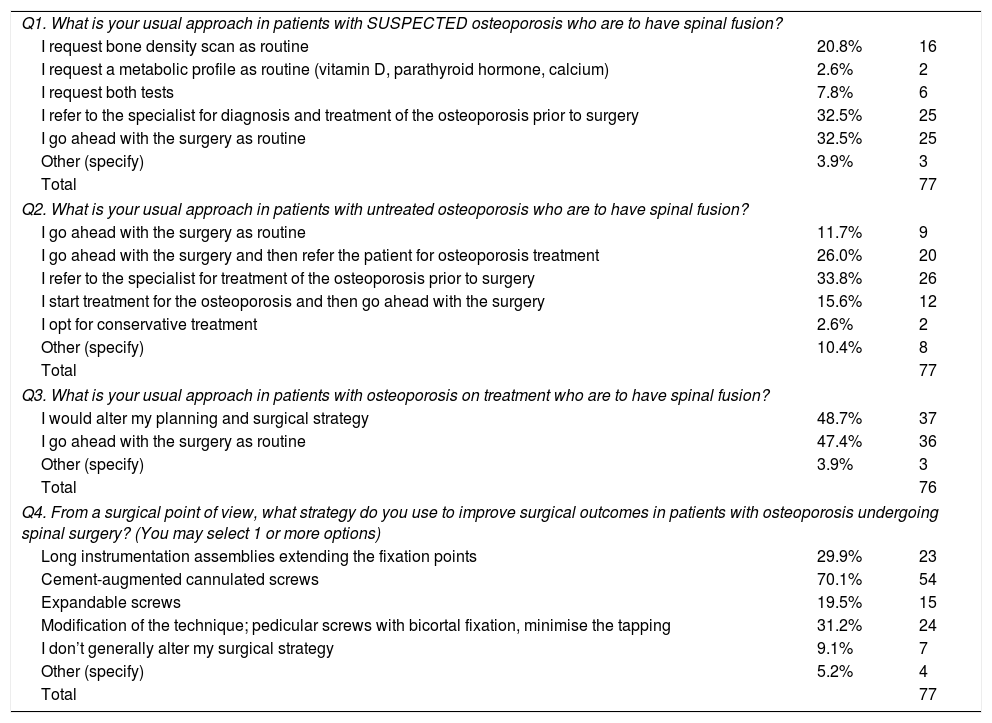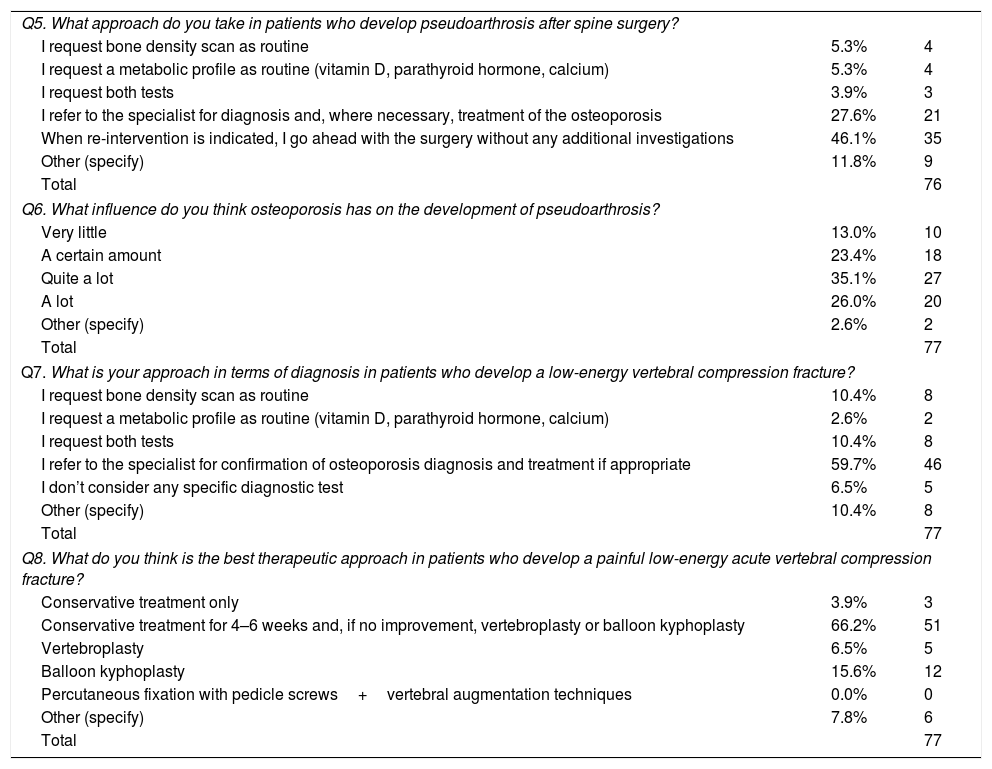Neurosurgeons and other specialists are increasingly having to treat patients with osteoporosis who require spinal fusion surgery.
Although there are effective pharmacological treatments and innovations in surgical techniques that can benefit these patients, low rates of diagnosis and preoperative treatment of osteoporosis have been reported, in addition to the limited participation of spine surgeons in this area.
The objective of this study was to evaluate trends in diagnosis and treatment of osteoporosis with regard to spine surgeons of the neurosurgical community.
Material and methodsAn electronic survey with 10 multiple-choice questions was issued to Spanish Neurosurgery Society (SENEC) members. The following were evaluated: (1) the surgeon's role regarding osteoporosis in spinal arthrodesis, (2) the influence of osteoporosis in pseudarthrosis, and (3) treatment trends in relation to osteoporotic vertebral fractures.
ResultsA total of 77 completed questionnaires were obtained. In patients with suspected osteoporosis, 32.5% of respondents did not consider any measure to diagnose it before spinal arthrodesis. In osteoporosis without treatment, 37.7% would proceed with surgery without treatment or would do so after surgery. A total of 48% of respondents would choose to modify their surgical strategy in patients with osteoporosis. The preferred surgical technique was the placement of augmentation screws (70%). In pseudarthrosis, 46.1% did not consider an osteoporosis diagnosis to be necessary for a reoperation. In osteoporotic vertebral fractures, 80.5% of surgeons considered some measure that would facilitate the treatment of osteoporosis.
ConclusionsGreater participation of the spine surgeon could improve the diagnosis and preoperative treatment of osteoporosis in spinal arthrodesis surgery and pseudarthrosis. In vertebral fractures, there is greater awareness of the optimisation of treatment and monitoring of osteoporosis.
Con cada vez mayor frecuencia neurocirujanos y otros especialistas nos vemos afrontados al tratamiento de pacientes con osteoporosis que requieren una cirugía de fusión de columna.
Pese a existir tratamientos farmacológicos efectivos e innovaciones en las técnicas quirúrgicas que pueden beneficiar a estos pacientes, se han reportado tasas bajas de diagnóstico y tratamiento preoperatorio de osteoporosis, además de una escasa participación de los cirujanos de columna en este ámbito.
El objetivo de este estudio fue evaluar las tendencias en el diagnóstico y tratamiento respecto a la osteoporosis en los cirujanos de raquis de la comunidad neuroquirúrgica.
Material y métodosSe realizó una encuesta electrónica con 10 preguntas de opción múltiple a los miembros de la Sociedad Española de Neurocirugía (SENEC). Se valoraron: 1) papel del cirujano de columna frente a la osteoporosis en la artrodesis de raquis, 2) la influencia de osteoporosis en la seudoartrosis y 3) tendencias de tratamiento respecto a las fracturas vertebrales osteoporóticas.
ResultadosObtuvimos un total de 77 cuestionarios respondidos. En los pacientes con sospecha de osteoporosis, un 32,5% de los encuestados no se plantea ninguna medida para diagnosticarla antes de una artrodesis vertebral. En osteoporóticos sin tratamiento, un 37,7% procedería con la cirugía sin tratamiento o lo haría después de la cirugía. El 48% de los respondedores optaría por modificar su estrategia quirúrgica en los pacientes con osteoporosis. La técnica quirúrgica preferida fue la colocación de tornillos cementados (70%). En la seudoartrosis, el 46,1% no considera necesario el diagnóstico de osteoporosis para una reintervención. En las fracturas vertebrales osteoporóticas, el 80,5% de los cirujanos se plantea alguna medida que facilitara el tratamiento de la osteoporosis.
ConclusionesUna mayor participación del cirujano de columna mejoraría el diagnóstico y tratamiento preoperatorio de la osteoporosis en las cirugías de artrodesis vertebral y seudoartrosis. En las fracturas vertebrales existe una mejor concienciación para optimizar el tratamiento y el seguimiento de la osteoporosis.
Article

If it is the first time you have accessed you can obtain your credentials by contacting Elsevier Spain in suscripciones@elsevier.com or by calling our Customer Service at902 88 87 40 if you are calling from Spain or at +34 932 418 800 (from 9 to 18h., GMT + 1) if you are calling outside of Spain.
If you already have your login data, please click here .
If you have forgotten your password you can you can recover it by clicking here and selecting the option ¿I have forgotten my password¿.














